Formulation and Stability of Quercetin-Loaded Pickering Emulsions Using Chitosan/Gum Arabic Nanoparticles for Topical Skincare Applications
Abstract
1. Introduction
2. Materials and Methods
2.1. Materials
2.2. Preparation of Pickering Emulsions Base
2.2.1. Chitosan and Gum Arabic Nanoparticle Preparation
2.2.2. Screening of CH/GA Nanoparticle Concentration and Oil Volume Fraction Using Olive Oil
2.2.3. Screening of Oil Type and Volume Fraction for Pickering Emulsion Base
2.3. Preparation of Quercetin-Loaded Pickering Emulsions
2.4. Physicochemical Characterization of Quercetin-Loaded Pickering Emulsions
Morphological Observation by Confocal Laser Scanning Microscopy (CLSM)
2.5. Stability Study of Quercetin-Loaded Pickering Emulsions
2.5.1. Storage Conditions
2.5.2. Physical Appearance
2.5.3. Light Microscopy
2.5.4. Particle Size and Size Distribution
2.5.5. Rheological Behavior and Viscosity
2.5.6. Quercetin Content Determination by High-Performance Liquid Chromatography
2.5.7. Antioxidant Activity Using DPPH Assay
2.6. Cytotoxicity Test
2.7. Measurement of Intracellular Reactive Oxygen Species
2.8. Statistic Statistical Analysis
3. Results and Discussion
3.1. Effect of CH/GA Nanoparticle Concentration and Oil Volume Fraction on the Physical Appearance of Pickering Emulsions
3.2. Effect of Oil Type and Volume Fraction on the Physical Appearance of Pickering Emulsions
3.3. Morphological Observation by CLSM
3.4. Stability Study
3.4.1. Physical Appearance and Particle Morphology
3.4.2. Particle Size and Size Distribution Analysis
3.4.3. Rheological Behavior and Viscosity Analysis
3.4.4. Quercetin Content Determination by HPLC
3.4.5. Free Radical Scavenging Activity
3.5. Cytotoxicity Assessment
3.6. Effect of Quercetin Loaed-Pickering Emulsions on Intracellular ROS Levels
4. Conclusions
Supplementary Materials
Author Contributions
Funding
Institutional Review Board Statement
Data Availability Statement
Acknowledgments
Conflicts of Interest
References
- Boots, A.W.; Haenen, G.R.; Bast, A. Health effects of quercetin: From antioxidant to nutraceutical. Eur. J. Pharmacol. 2008, 585, 325–337. [Google Scholar] [CrossRef] [PubMed]
- Li, Y.; Yao, J.; Han, C.; Yang, J.; Chaudhry, M.T.; Wang, S.; Liu, H.; Yin, Y. Quercetin, Inflammation and Immunity. Nutrients 2016, 8, 167. [Google Scholar] [CrossRef] [PubMed]
- Beken, B.; Serttas, R.; Yazicioglu, M.; Turkekul, K.; Erdogan, S. Quercetin Improves Inflammation, Oxidative Stress, and Impaired Wound Healing in Atopic Dermatitis Model of Human Keratinocytes. Pediatr. Allergy Immunol. Pulmonol. 2020, 33, 69–79. [Google Scholar] [CrossRef]
- Wang, W.; Sun, C.; Mao, L.; Ma, P.; Liu, F.; Yang, J.; Gao, Y. The biological activities, chemical stability, metabolism and delivery systems of quercetin: A review. Trends Food Sci. Technol. 2016, 56, 21–38. [Google Scholar] [CrossRef]
- Hozhabr Araghi, S.; Amalraj, J.; Sadeghi Googheri, M.; Pyarasani, R.D.; Sadeghi Googheri, M.S. An in-silico study to gain a comprehensive understanding of the effects of glucosylation on quercetin properties. Comput. Theor. Chem. 2023, 1220, 113981. [Google Scholar] [CrossRef]
- Tretyakova, I.S.; Rychkov, D.A.; Kil’met’ev, A.S.; Lomovskiy, I.O. Computational study of chemical phenol glycosylation mechanism in the gas phase for modeling direct glycoconjugate formation in raw plant material. Comput. Theor. Chem. 2023, 1225, 114182. [Google Scholar] [CrossRef]
- Wang, J.; Xue, X.; Miao, X. Antioxidant Effects of Quercetin Nanocrystals in Nanosuspension against Hydrogen Peroxide-Induced Oxidative Stress in a Zebrafish Model. Pharmaceuticals 2023, 16, 1209. [Google Scholar] [CrossRef]
- Zielinska, D.; Wiczkowski, W.; Piskula, M.K. Determination of the Relative Contribution of Quercetin and Its Glucosides to the Antioxidant Capacity of Onion by Cyclic Voltammetry and Spectrophotometric Methods. J. Agric. Food Chem. 2008, 56, 3524–3531. [Google Scholar] [CrossRef]
- Kakran, M.; Shegokar, R.; Sahoo, N.G.; Gohla, S.; Li, L.; Müller, R.H. Long-term stability of quercetin nanocrystals prepared by different methods. J. Pharm. Pharmacol. 2012, 64, 1394–1402. [Google Scholar] [CrossRef]
- Kandemir, K.; Tomas, M.; McClements, D.J.; Capanoglu, E. Recent advances on the improvement of quercetin bioavailability. Trends Food Sci. Technol. 2022, 119, 192–200. [Google Scholar] [CrossRef]
- Wang, G.; Li, J.; Yan, X.; Meng, Y.; Zhang, Y.; Chang, X.; Cai, J.; Liu, S.; Ding, W. Stability and Bioaccessibility of Quercetin-Enriched Pickering Emulsion Gels Stabilized by Cellulose Nanocrystals Extracted from Rice Bran. Polymers 2024, 16, 868. [Google Scholar] [CrossRef] [PubMed]
- Ye, L.; Wang, Y.; Lu, X. Pickering emulsion stabilized by quercetin-β-cyclodextrin-diglyceride particles: Effect of diglyceride content on interfacial behavior and emulsifying property of complex particles. Food Chem. 2024, 455, 139901. [Google Scholar] [CrossRef] [PubMed]
- Meng, W.; Sun, H.; Mu, T.; Garcia-Vaquero, M. Chitosan-based Pickering emulsion: A comprehensive review on their stabilizers, bioavailability, applications and regulations. Carbohydr. Polym. 2023, 304, 120491. [Google Scholar] [CrossRef]
- Sharkawy, A.; Barreiro, M.F.; Rodrigues, A.E. Chitosan-based Pickering emulsions and their applications: A review. Carbohydr. Polym. 2020, 250, 116885. [Google Scholar] [CrossRef] [PubMed]
- Sharkawy, A.; Barreiro, F.; Rodrigues, A. Pickering emulsions stabilized with chitosan/gum Arabic particles: Effect of chitosan degree of deacetylation on the physicochemical properties and cannabidiol (CBD) topical delivery. J. Mol. Liq. 2022, 355, 118993. [Google Scholar] [CrossRef]
- Mohamed, S.A.; Elsherbini, A.M.; Alrefaey, H.R.; Adelrahman, K.; Moustafa, A.; Egodawaththa, N.M.; Crawford, K.E.; Nesnas, N.; Sabra, S.A. Gum Arabic: A Commodity with Versatile Formulations and Applications. Nanomaterials 2025, 15, 290. [Google Scholar] [CrossRef]
- Baghban, N.; Momeni, S.; Behboudi, E.; Dianat-Moghadam, H.; Darabi, A.; Targhi, H.S.; Keshavarz, M. Green synthesis of MnO(2) NPs using Arabic gum: Assessing its potential antiviral activity against influenza A/H1N1. Virol. J. 2024, 21, 48. [Google Scholar] [CrossRef]
- Ai, C.; Zhao, C.; Xiang, C.; Zheng, Y.; Zhong, S.; Teng, H.; Chen, L. Gum arabic as a sole wall material for constructing nanoparticle to enhance the stability and bioavailability of curcumin. Food Chem. X 2023, 18, 100724. [Google Scholar] [CrossRef]
- Kim, E.S.; Kim, D.Y.; Lee, J.S.; Lee, H.G. Mucoadhesive Chitosan-Gum Arabic Nanoparticles Enhance the Absorption and Antioxidant Activity of Quercetin in the Intestinal Cellular Environment. J. Agric. Food Chem. 2019, 67, 8609–8616. [Google Scholar] [CrossRef]
- Tan, C.; Xie, J.; Zhang, X.; Cai, J.; Xia, S. Polysaccharide-based nanoparticles by chitosan and gum arabic polyelectrolyte complexation as carriers for curcumin. Food Hydrocoll. 2016, 57, 236–245. [Google Scholar] [CrossRef]
- Lobato-Guarnido, I.; Luzón, G.; Ríos, F.; Fernández-Serrano, M. Synthesis and Characterization of Environmentally Friendly Chitosan–Arabic Gum Nanoparticles for Encapsulation of Oregano Essential Oil in Pickering Emulsion. Nanomaterials 2023, 13, 2651. [Google Scholar] [CrossRef] [PubMed]
- Wang, H.; Shao, Q.; Zhang, Y.; Ding, J.; Yang, M.; Yang, L.; Wang, W.; Cui, P.; Dai, Z.; Ma, L. Preparation and Evaluation of Liposomes Containing Ethanol and Propylene Glycol as Carriers for Nicotine. Curr. Drug Deliv. 2024, 21, 249–260. [Google Scholar] [CrossRef] [PubMed]
- Sharkawy, A.; Barreiro, M.F.; Rodrigues, A.E. Preparation of chitosan/gum Arabic nanoparticles and their use as novel stabilizers in oil/water Pickering emulsions. Carbohydr. Polym. 2019, 224, 115190. [Google Scholar] [CrossRef]
- Yuan, D.B.; Hu, Y.Q.; Zeng, T.; Yin, S.W.; Tang, C.H.; Yang, X.Q. Development of stable Pickering emulsions/oil powders and Pickering HIPEs stabilized by gliadin/chitosan complex particles. Food Funct. 2017, 8, 2220–2230. [Google Scholar] [CrossRef] [PubMed]
- Sawangwong, W.; Kiattisin, K.; Somwongin, S.; Wongrattanakamon, P.; Chaiyana, W.; Poomanee, W.; Sainakham, M. The assessment of composition, biological properties, safety and molecular docking of corn silk (Zea mays L.) extracts from the valorization of agricultural waste products in Thailand. Ind. Crops Prod. 2024, 212, 118352. [Google Scholar] [CrossRef]
- Sainakham, M.; Jantrawut, P.; Kiattisin, K.; Chittasupho, C.; Singh, S. Potential of green extraction using edible deep eutectic solvents on the bioactivities from Curcuma aromatica rhizome extracts for food application. J. Agric. Food Res. 2023, 14, 100868. [Google Scholar] [CrossRef]
- Han, L.; Xia, X.; Xiang, X.; Huang, F.; Zhang, Z. Protective effects of canolol against hydrogen peroxide-induced oxidative stress in AGS cells. RSC Adv. 2017, 7, 42826–42832. [Google Scholar] [CrossRef]
- Li, J.; Xu, X.; Chen, Z.; Wang, T.; Lu, Z.; Hu, W.; Wang, L. Zein/gum Arabic nanoparticle-stabilized Pickering emulsion with thymol as an antibacterial delivery system. Carbohydr. Polym. 2018, 200, 416–426. [Google Scholar] [CrossRef]
- Aveyard, R.; Binks, B.P.; Clint, J.H. Emulsions stabilised solely by colloidal particles. Adv. Colloid Interface Sci. 2003, 100–102, 503–546. [Google Scholar] [CrossRef]
- Frelichowska, J.; Bolzinger, M.-A.; Chevalier, Y. Effects of solid particle content on properties of o/w Pickering emulsions. J. Colloid Interface Sci. 2010, 351, 348–356. [Google Scholar] [CrossRef]
- Zhao, G.; Wang, S.; Yang, H.; Yang, L.; Song, H.; Zhang, G.; Liu, H.; He, Y. Impact of oil volume fraction on stability of Pickering emulsion prepared by silica particles and soy hull polysaccharides. J. Food Eng. 2025, 397, 112601. [Google Scholar] [CrossRef]
- Xu, W.; Li, Z.; Li, H.; Sun, H.; Zheng, S.; Luo, D.; Li, Y.; Wang, Y.; Shah, B.R. Stabilization and microstructural network of pickering emulsion using different xanthan gum/lysozyme nanoparticle concentrations. LWT 2022, 160, 113298. [Google Scholar] [CrossRef]
- Davtalab, M.; Naji-Tabasi, S.; Shahidi-Noghabi, M.; Martins, A.J.; Bourbon, A.I.; Cerqueira, M.A. Pickering Emulsion Stabilized by Different Concentrations of Whey Protein–Cress Seed Gum Nanoparticles. Foods 2024, 13, 3777. [Google Scholar] [CrossRef]
- Perrin, L.; Gillet, G.; Gressin, L.; Desobry, S. Interest of Pickering Emulsions for Sustainable Micro/Nanocellulose in Food and Cosmetic Applications. Polymers 2020, 12, 2385. [Google Scholar] [CrossRef] [PubMed]
- Chen, Z.; Dong, M.; Husein, M.; Bryant, S. Effects of Oil Viscosity on the Plugging Performance of Oil-in-Water Emulsion in Porous Media. Ind. Eng. Chem. Res. 2018, 57, 7301–7309. [Google Scholar] [CrossRef]
- Binks, B.P.; Lumsdon, S.O. Effects of oil type and aqueous phase composition on oil–water mixtures containing particles of intermediate hydrophobicity. Phys. Chem. Chem. Phys. 2000, 2, 2959–2967. [Google Scholar] [CrossRef]
- Torres, L.G.; Iturbe, R.; Snowden, M.J.; Chowdhry, B.Z.; Leharne, S.A. Preparation of o/w emulsions stabilized by solid particles and their characterization by oscillatory rheology. Colloids Surf. A Physicochem. Eng. Asp. 2007, 302, 439–448. [Google Scholar] [CrossRef]
- Dai, L.; Zhan, X.; Wei, Y.; Sun, C.; Mao, L.; McClements, D.J.; Gao, Y. Composite zein—propylene glycol alginate particles prepared using solvent evaporation: Characterization and application as Pickering emulsion stabilizers. Food Hydrocoll. 2018, 85, 281–290. [Google Scholar] [CrossRef]
- Saikia, T.; Sultan, A.; Barri, A.A.; Khamidy, N.I.; Shamsan, A.A.; Almohsin, A.; Bataweel, M. Development of pickering emulsified polymeric gel system for conformance control in high temperature reservoirs. J. Pet. Sci. Eng. 2020, 184, 106596. [Google Scholar] [CrossRef]
- Nan, F.; Wu, J.; Qi, F.; Fan, Q.; Ma, G.; Ngai, T. Preparation of uniform-sized colloidosomes based on chitosan-coated alginate particles and its application for oral insulin delivery. J. Mater. Chem. B 2014, 2, 7403–7409. [Google Scholar] [CrossRef]
- Ge, S.; Xiong, L.; Li, M.; Liu, J.; Yang, J.; Chang, R.; Liang, C.; Sun, Q. Characterizations of Pickering emulsions stabilized by starch nanoparticles: Influence of starch variety and particle size. Food Chem. 2017, 234, 339–347. [Google Scholar] [CrossRef]
- Yousufi, M.M.; Dzulkarnain, I.b.; Elhaj, M.E.M.; Ahmed, S. A Perspective on the Prospect of Pickering Emulsion in Reservoir Conformance Control with Insight into the Influential Parameters and Characterization Techniques. Processes 2023, 11, 2672. [Google Scholar] [CrossRef]
- Tao, Y.; Wang, P.; Xu, X.; Chen, J.; Huang, M.; Zhang, W. Effects of ultrasound treatment on the morphological characteristics, structures and emulsifying properties of genipin cross-linked myofibrillar protein. Ultrason. Sonochem. 2023, 97, 106467. [Google Scholar] [CrossRef] [PubMed]
- Bucciantini, M.; Leri, M.; Nardiello, P.; Casamenti, F.; Stefani, M. Olive Polyphenols: Antioxidant and Anti-Inflammatory Properties. Antioxidants 2021, 10, 1044. [Google Scholar] [CrossRef] [PubMed]
- Uncu, O.; Ozen, B. Importance of some minor compounds in olive oil authenticity and quality. Trends Food Sci. Technol. 2020, 100, 164–176. [Google Scholar] [CrossRef]
- Ren, J.-N.; Dong, M.; Hou, Y.-Y.; Fan, G.; Pan, S.-Y. Effect of olive oil on the preparation of nanoemulsions and its effect on aroma release. J. Food Sci. Technol. 2018, 55, 4223–4231. [Google Scholar] [CrossRef]
- Han, J.; Chen, F.; Gao, C.; Zhang, Y.; Tang, X. Environmental stability and curcumin release properties of Pickering emulsion stabilized by chitosan/gum arabic nanoparticles. Int. J. Biol. Macromol. 2020, 157, 202–211. [Google Scholar] [CrossRef]
- Zhang, N.; Han, J.; Chen, F.; Gao, C.; Tang, X. Chitosan/gum arabic complexes to stabilize Pickering emulsions: Relationship between the preparation, structure and oil-water interfacial activity. Food Hydrocoll. 2022, 129, 107532. [Google Scholar] [CrossRef]
- Espín, J.C.; Soler-Rivas, C.; Wichers, H.J. Characterization of the total free radical scavenger capacity of vegetable oils and oil fractions using 2,2-diphenyl-1-picrylhydrazyl radical. J. Agric. Food Chem. 2000, 48, 648–656. [Google Scholar] [CrossRef]
- Li, Y.; Ma, W.J.; Qi, B.K.; Rokayya, S.; Li, D.; Wang, J.; Feng, H.X.; Sui, X.N.; Jiang, L.Z. Blending of soybean oil with selected vegetable oils: Impact on oxidative stability and radical scavenging activity. Asian Pac. J. Cancer Prev. 2014, 15, 2583–2589. [Google Scholar] [CrossRef]
- Visioli, F.; Bellomo, G.; Galli, C. Free radical-scavenging properties of olive oil polyphenols. Biochem. Biophys. Res. Commun. 1998, 247, 60–64. [Google Scholar] [CrossRef] [PubMed]
- Samaniego Sánchez, C.; Troncoso González, A.M.; García-Parrilla, M.C.; Quesada Granados, J.J.; López García de la Serrana, H.; López Martínez, M.C. Different radical scavenging tests in virgin olive oil and their relation to the total phenol content. Anal. Chim. Acta 2007, 593, 103–107. [Google Scholar] [CrossRef] [PubMed]
- Wu, J.; Ma, G.H. Pickering Emulsions: Recent Studies of Pickering Emulsions: Particles Make the Difference (Small 34/2016). Small 2016, 12, 4582. [Google Scholar] [CrossRef]
- Chang, C.; Li, X.; Zhai, J.; Su, Y.; Gu, L.; Li, J.; Yang, Y. Stability of protein particle based Pickering emulsions in various environments: Review on strategies to inhibit coalescence and oxidation. Food Chem. X 2023, 18, 100651. [Google Scholar] [CrossRef]
- Keramat, M.; Kheynoor, N.; Golmakani, M.-T. Oxidative stability of Pickering emulsions. Food Chem. X 2022, 14, 100279. [Google Scholar] [CrossRef]


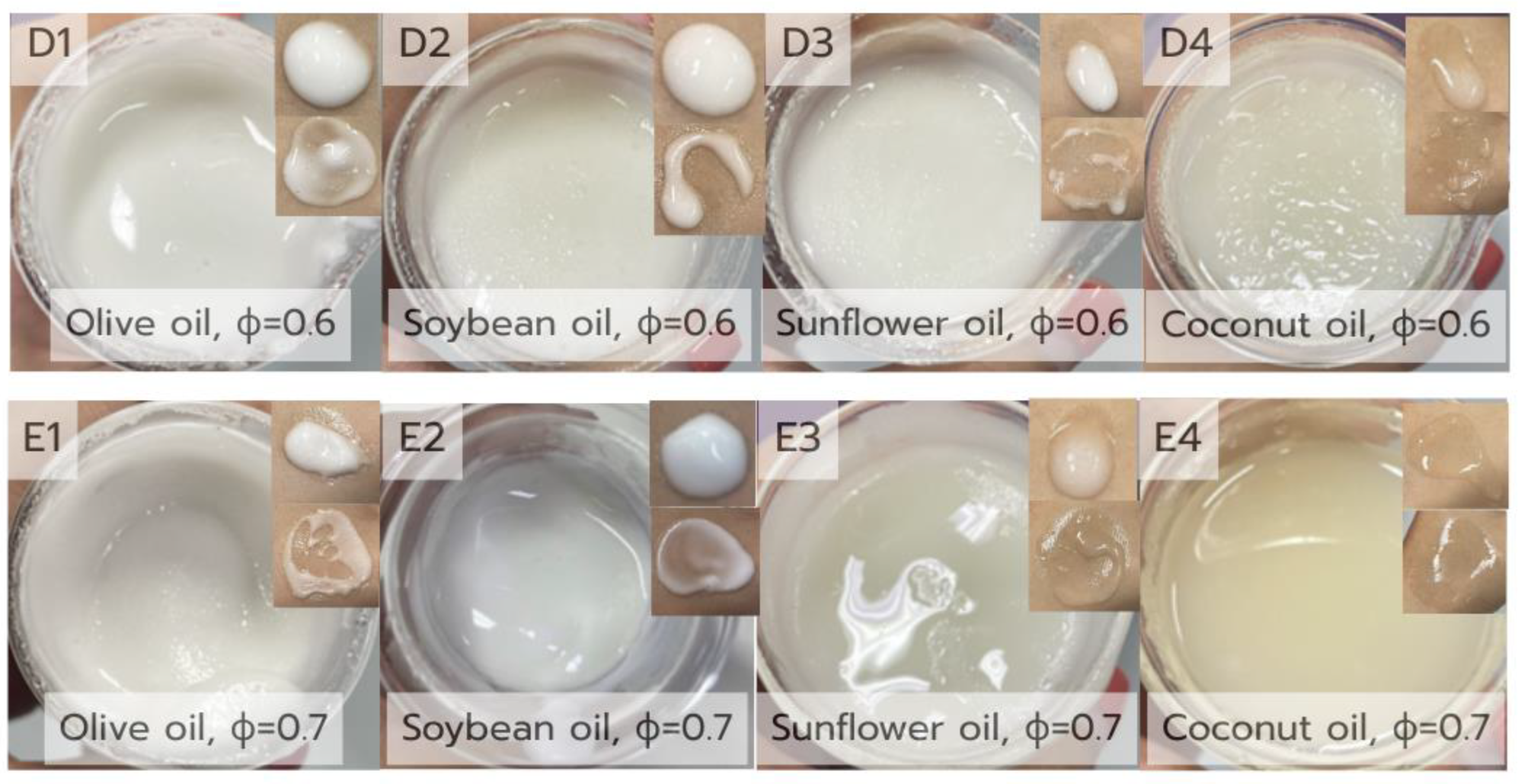
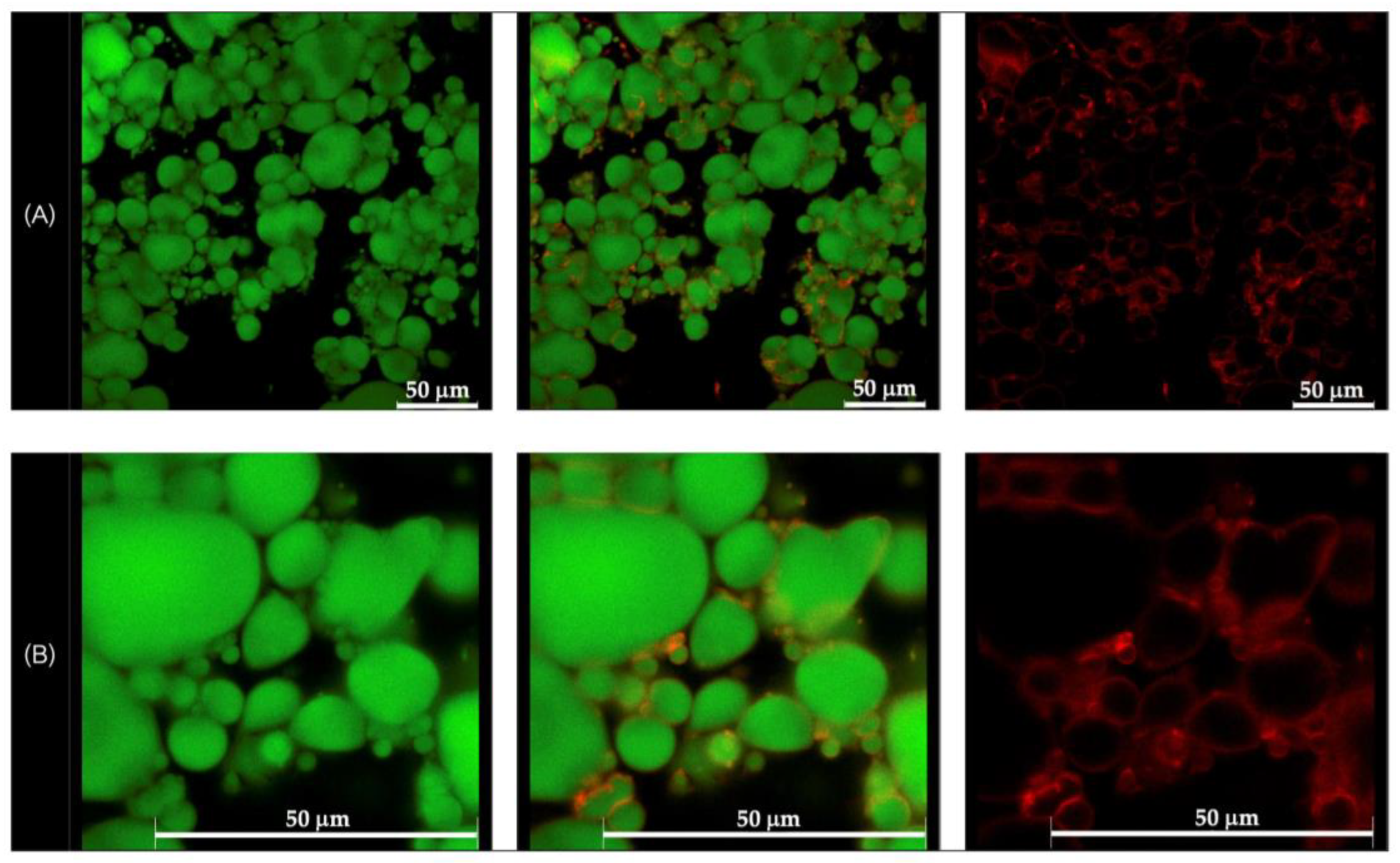
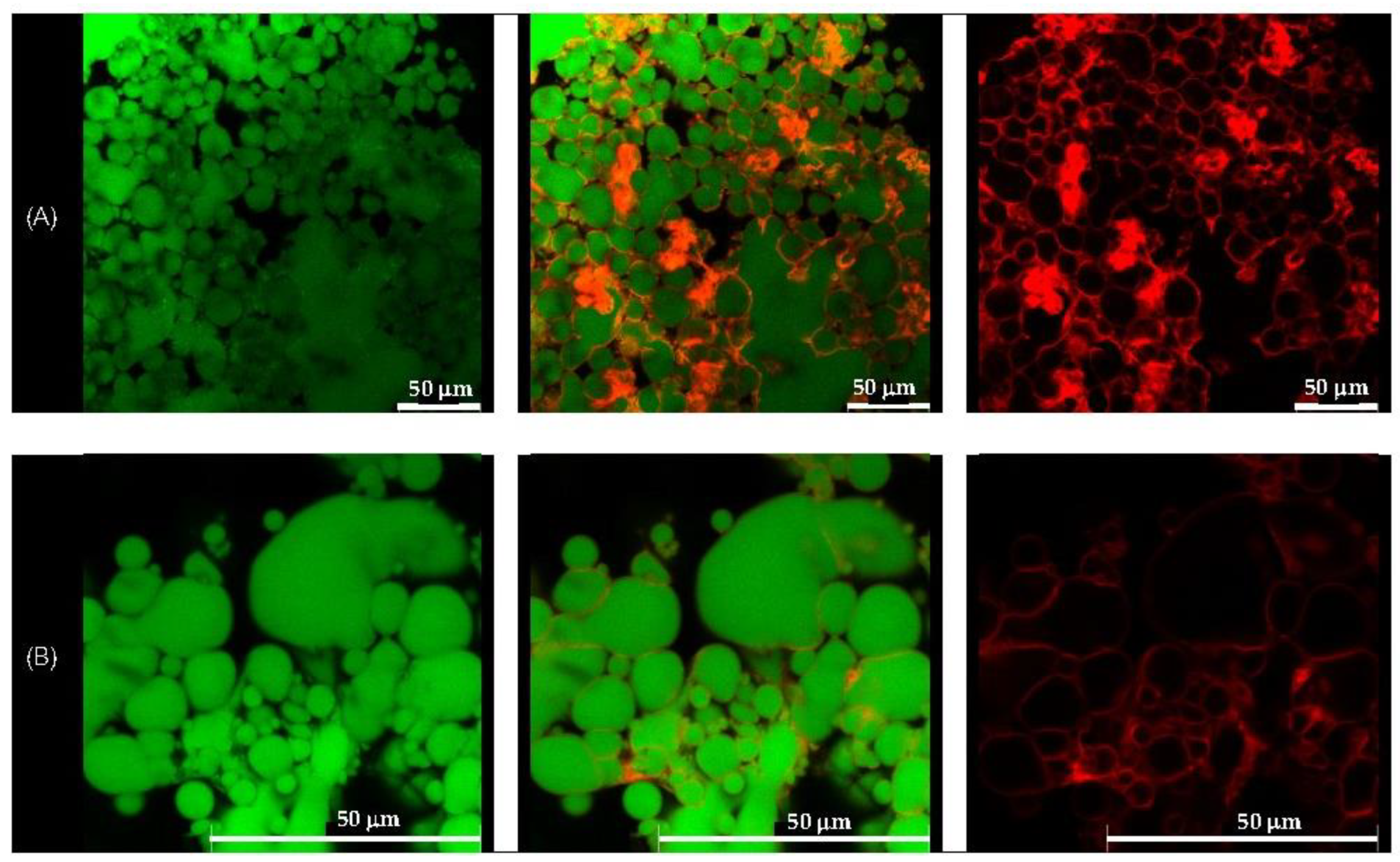
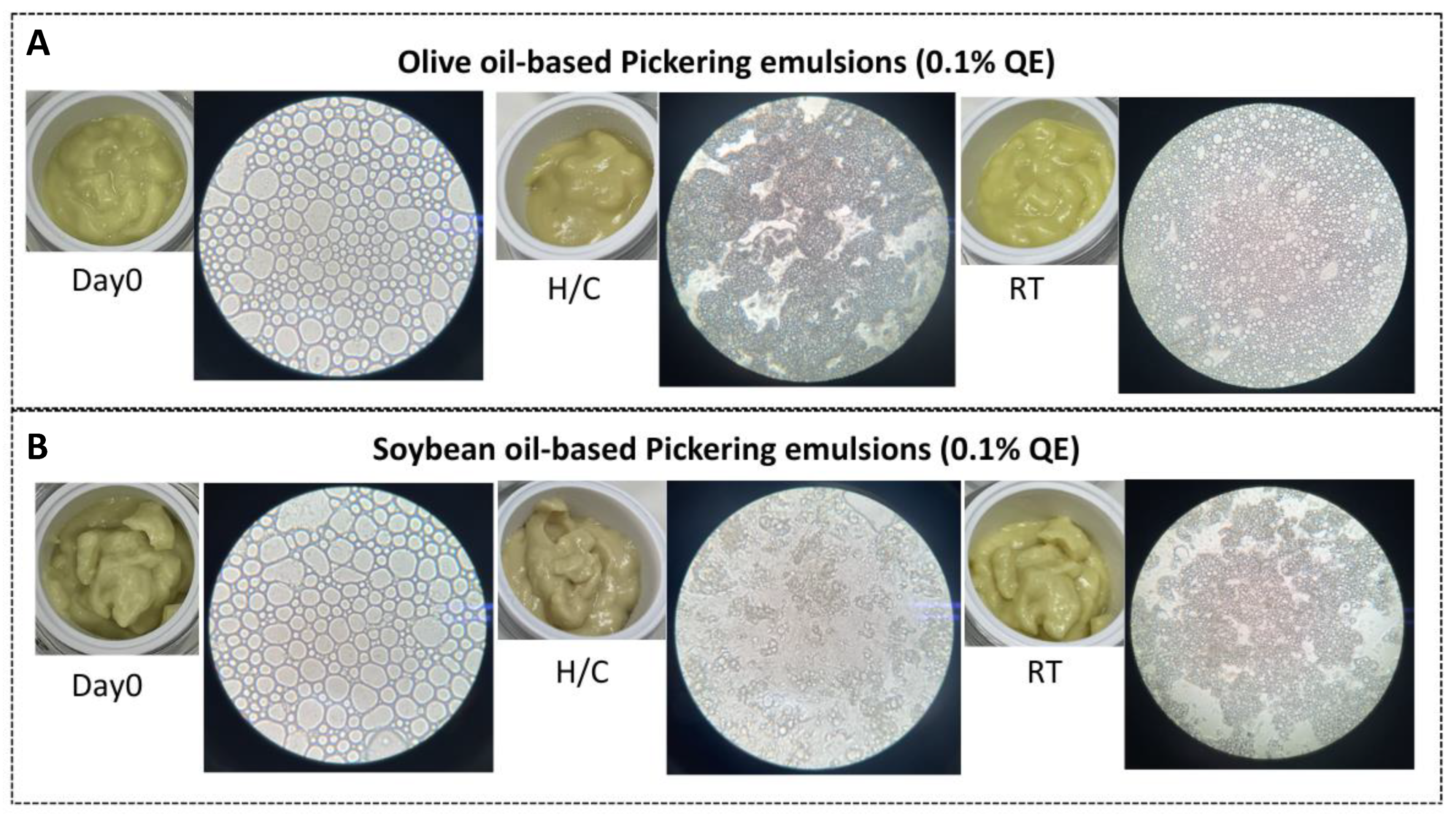
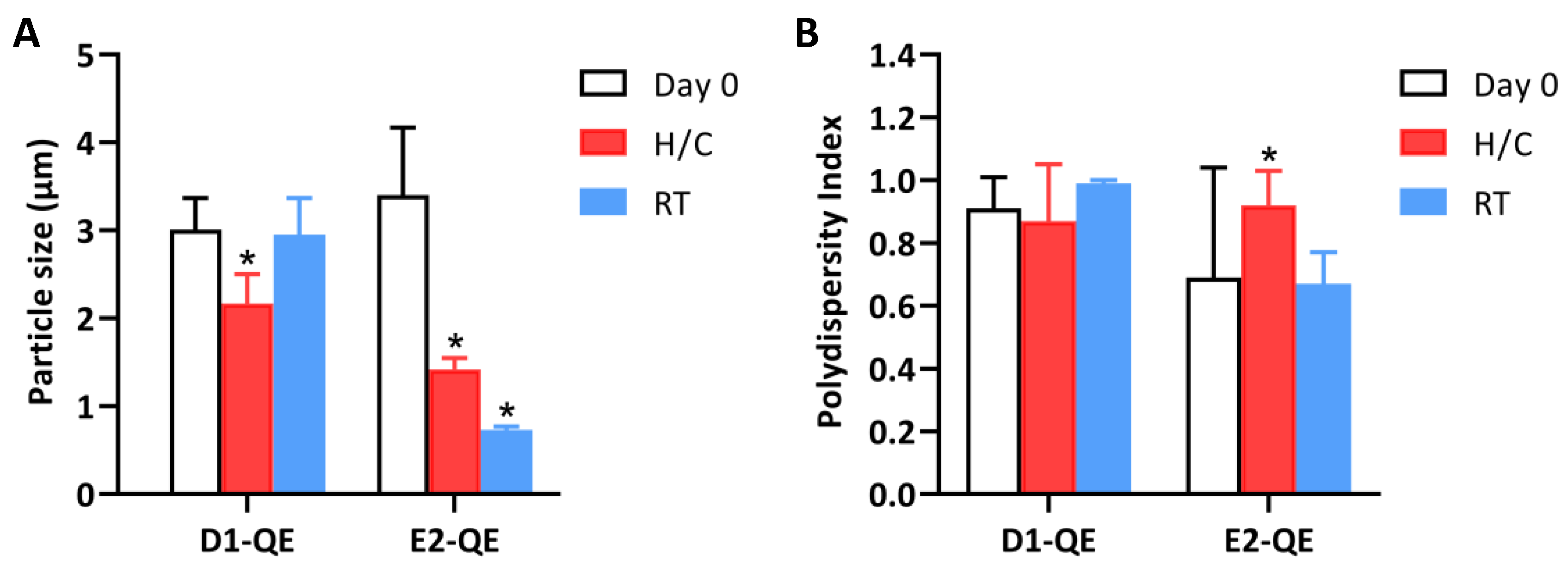
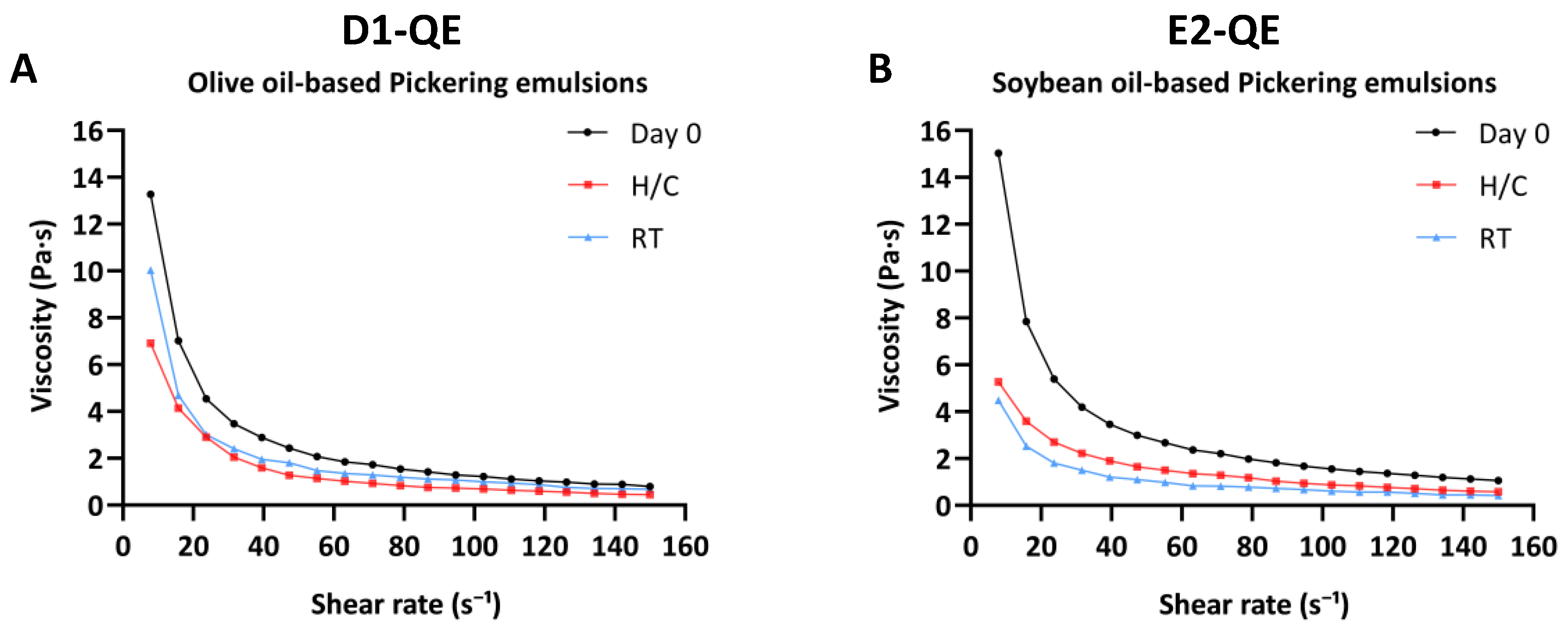
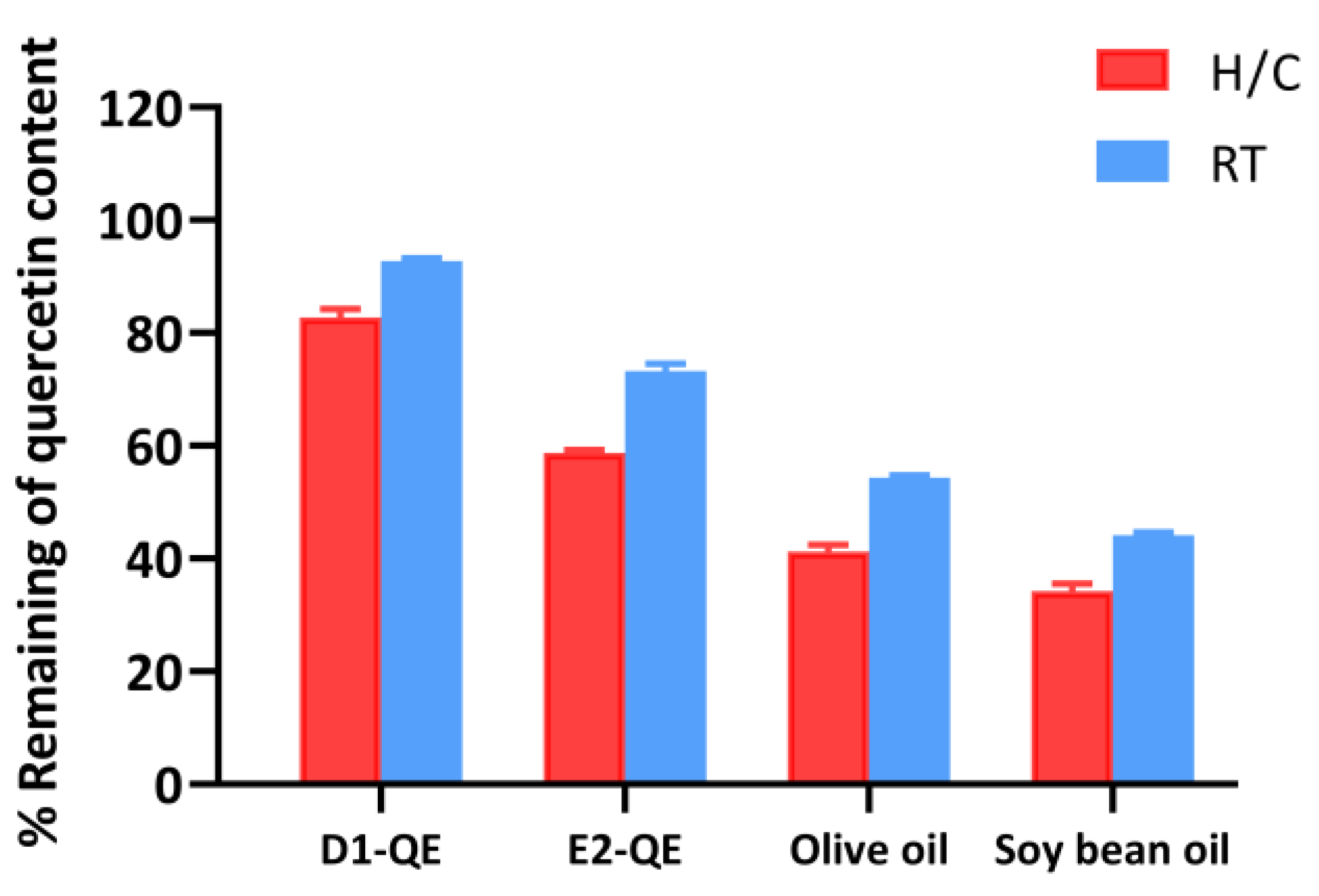
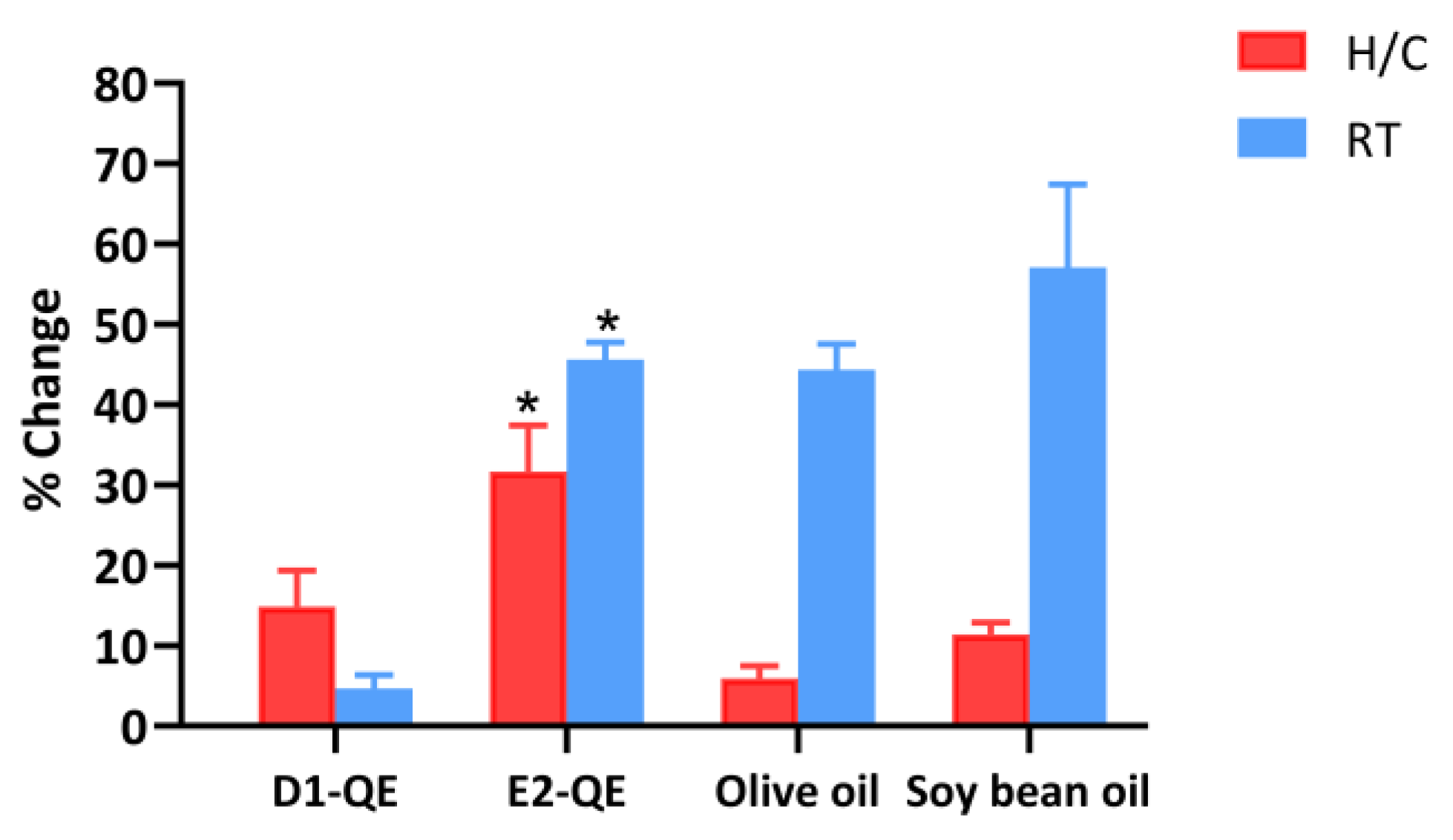
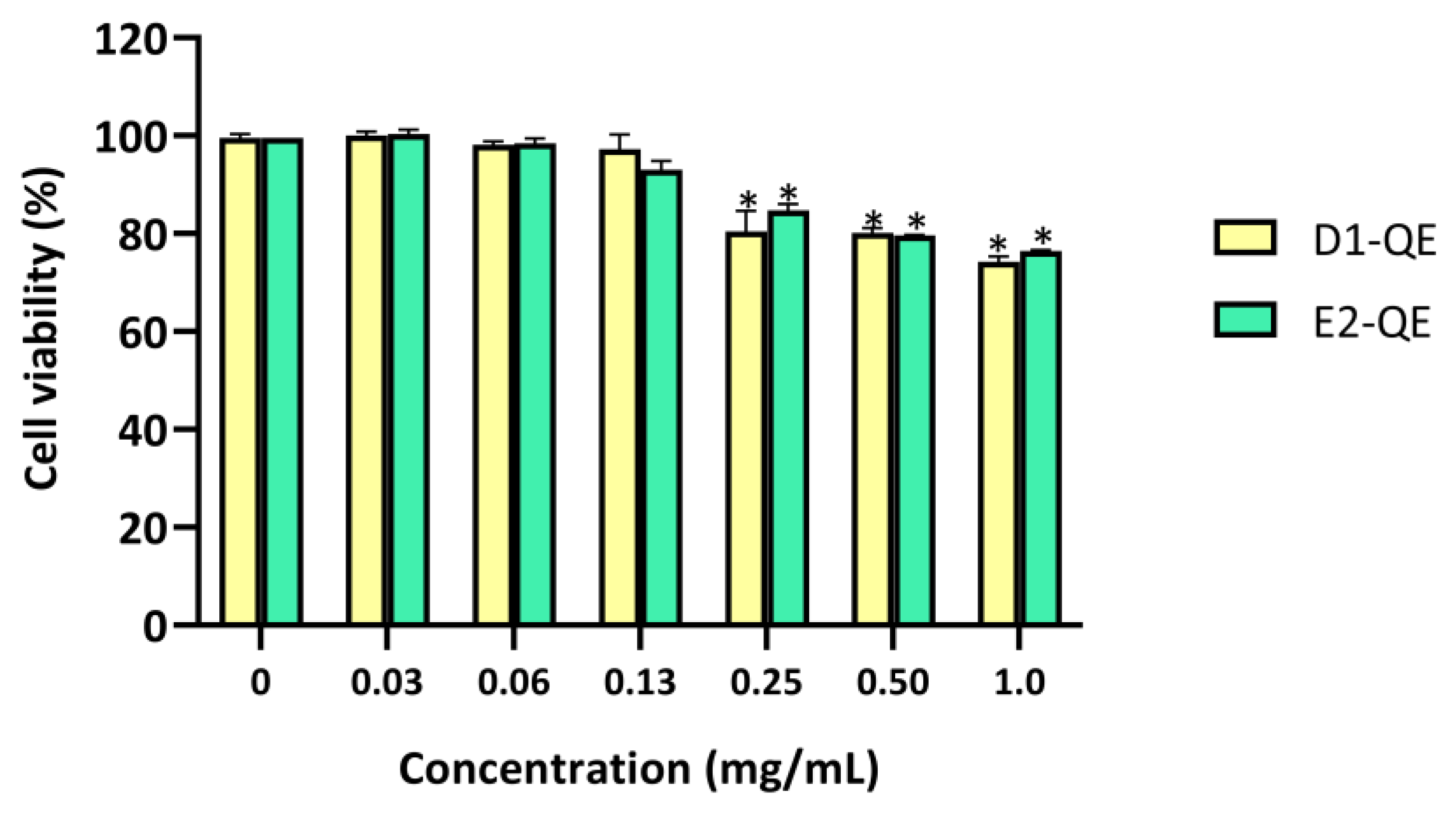
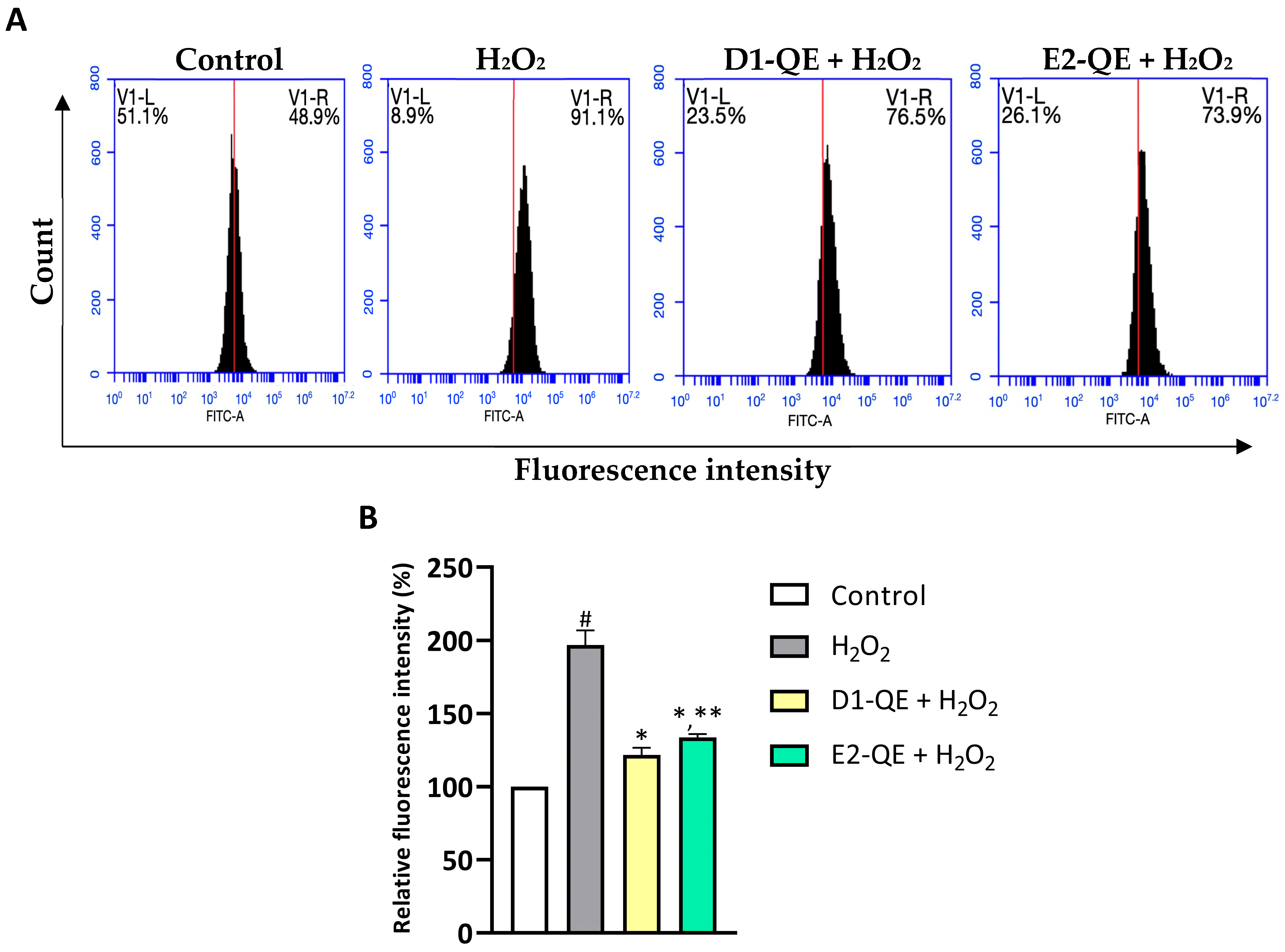
| Formulation | CH/GA Nanoparticles (% w/v) | Oil Volume Fraction (ϕ) |
|---|---|---|
| A | 0.5 | 0.6 |
| B | 0.5 | 0.7 |
| C | 1.5 | 0.5 |
| D | 1.5 | 0.6 |
| E | 1.5 | 0.7 |
| F | 2.0 | 0.5 |
| G | 2.0 | 0.6 |
| H | 2.0 | 0.7 |
| Formulation | Oil Type | CH/GA Nanoparticles (% w/v) | Oil Volume Fraction (ϕ) |
|---|---|---|---|
| D1 | Olive oil | 1.5 | 0.6 |
| D2 | Soybean oil | 1.5 | 0.6 |
| D3 | Sunflower oil | 1.5 | 0.6 |
| D4 | Coconut oil | 1.5 | 0.6 |
| E1 | Olive oil | 1.5 | 0.7 |
| E2 | Soybean oil | 1.5 | 0.7 |
| E3 | Sunflower oil | 1.5 | 0.7 |
| E4 | Coconut oil | 1.5 | 0.7 |
| Formulation | Oil Type | CH/GA Nanoparticles (% w/v) | Oil Volume Fraction (ϕ) | Quercetin Concentration (% w/v) |
|---|---|---|---|---|
| D1-0.1 | Olive oil | 1.5 | 0.6 | 0.1 |
| D1-0.5 | Olive oil | 1.5 | 0.6 | 0.5 |
| D1-1.0 | Olive oil | 1.5 | 0.6 | 1.0 |
| E2-0.1 | Soybean oil | 1.5 | 0.7 | 0.1 |
| E2-0.5 | Soybean oil | 1.5 | 0.7 | 0.5 |
| E2-1.0 | Soybean oil | 1.5 | 0.7 | 1.0 |
| Samples | % Free Radical Scavenging | ||
|---|---|---|---|
| Day 0 | Heating-Cooling | Room Temperature | |
| D1-QE | 44.1 ± 1.3 | 37.5 ± 1.0 | 42.1 ± 2.0 |
| E2-QE | 48.7 ± 5.4 | 33.2 ± 3.8 * | 26.4 ± 2.0 * |
| Olive oil | 59.8 ± 2.0 | 56.2 ± 1.1 | 33.3 ± 2.9 * |
| Soybean oil | 50.2 ± 7.2 | 44.4 ± 6.3 | 21.1 ± 2.5 * |
Disclaimer/Publisher’s Note: The statements, opinions and data contained in all publications are solely those of the individual author(s) and contributor(s) and not of MDPI and/or the editor(s). MDPI and/or the editor(s) disclaim responsibility for any injury to people or property resulting from any ideas, methods, instructions or products referred to in the content. |
© 2025 by the authors. Licensee MDPI, Basel, Switzerland. This article is an open access article distributed under the terms and conditions of the Creative Commons Attribution (CC BY) license (https://creativecommons.org/licenses/by/4.0/).
Share and Cite
Sainakham, M.; Arunlakvilart, P.; Samran, N.; Vivattanaseth, P.; Preedalikit, W. Formulation and Stability of Quercetin-Loaded Pickering Emulsions Using Chitosan/Gum Arabic Nanoparticles for Topical Skincare Applications. Polymers 2025, 17, 1871. https://doi.org/10.3390/polym17131871
Sainakham M, Arunlakvilart P, Samran N, Vivattanaseth P, Preedalikit W. Formulation and Stability of Quercetin-Loaded Pickering Emulsions Using Chitosan/Gum Arabic Nanoparticles for Topical Skincare Applications. Polymers. 2025; 17(13):1871. https://doi.org/10.3390/polym17131871
Chicago/Turabian StyleSainakham, Mathukorn, Paemika Arunlakvilart, Napatwan Samran, Pattavet Vivattanaseth, and Weeraya Preedalikit. 2025. "Formulation and Stability of Quercetin-Loaded Pickering Emulsions Using Chitosan/Gum Arabic Nanoparticles for Topical Skincare Applications" Polymers 17, no. 13: 1871. https://doi.org/10.3390/polym17131871
APA StyleSainakham, M., Arunlakvilart, P., Samran, N., Vivattanaseth, P., & Preedalikit, W. (2025). Formulation and Stability of Quercetin-Loaded Pickering Emulsions Using Chitosan/Gum Arabic Nanoparticles for Topical Skincare Applications. Polymers, 17(13), 1871. https://doi.org/10.3390/polym17131871






